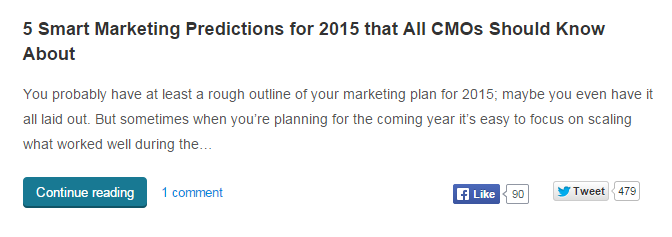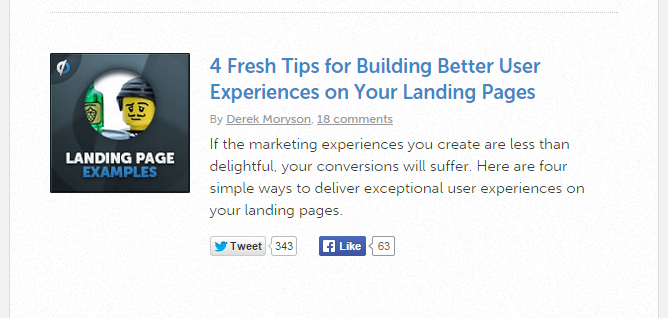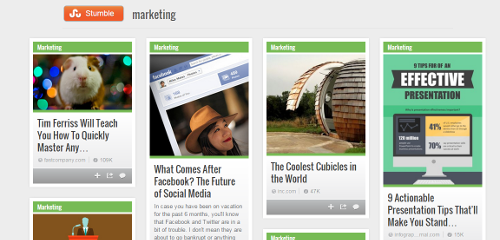
08 Dec The Beginners Guide to Business Blogging
Content marketing has been a prominent staple of many B2B strategies over the last few years, and the most foundational component of this is business blogging.
Most of us know how effective blogging can be, but many start out by creating a few blog posts, see little to zero results and then give up. The thing is, business blogging is an investment, and one you need to be persistent in.
Unbounce didn’t see much traction for the first 6 months of their content marketing efforts, but now they’re one of the leading resources on marketing and is their top source of traffic and conversions. It’s a long game, but one well worth playing.
In this post, I want to show you how to make business blogging work for you. You’re going to learn what we’ve done, what’s worked and how other B2B businesses are doing it successfully, too.
Over the last 4 months or so we’ve tested numerous methods of business blogging and believe we’ve found our sweet spot. We began by making short posts no more than 400 words long and did so in high quantity, and it helped our SEO but did little for overall traffic and conversions.
However, when we did the opposite the results were surprising. We had a huge lift in traffic from a single blog post, simply because it was in-depth and inherently useful.
We’re not trying to say that what we’ve done will definitely work for you also, but by testing different approaches you’ll eventually find what does work for you. You can try different things and then scale up the forms of content that works best for you.
This article is designed to get you started with business blogging as quickly as possible. I’ll show you how to build the platform, how to integrate your blog into your overall strategy and objectives and even how to amplify your content to generate more traffic.
Before we begin that though, you could be wondering what the point of business blogging is in the first place. What are the benefits here? Knowing these upfront can help guide your objectives and overall content marketing strategy, so let’s jump in.
Business Blogging Benefits
Creating a blog for your business has several benefits, all of which can be ticked off with a single article. Once you’ve nailed your content in a way that provides information people want, you’ll begin seeing your traffic, subscribers and SEO rankings grow.
Let’s start with authority and credibility. These are two fairly “fluffy” terms, but they do have a place. First of all, when you position yourself as an authority in your market, you build trust much more quickly and easily.
Becoming an authority in your space makes it easier for people to trust your message and want to discover more about you. Backing up your facts with case studies and market data makes this possible.
If your content is truly useful and exceptional then you’ll find that traffic will begin to grow naturally as a result. People will share it in communities, on social media and with their peers. Of course, you need to put in the effort to amplify your content first, which we’ll get on to later in this article.
Creating blog posts allows you to focus on long-tail SEO keywords and generate new search traffic beyond the core messaging of your value proposition. When we experimented with our blog for example, we decided to re-position it from a C-Suite Marketing focused blog to broader B2B marketing.

The first blog post we created under this new direction now ranks for several competitive B2B marketing keywords and is generating new traffic that we wouldn’t have received before. It allows us to tap into certain interests outside of our main offering, which exposes more people to it.
Finally, and most importantly, business blogging can guide this top-of-funnel (TOFU) traffic further down the funnel. You can offer new visitors something in exchange for their information, such as an eBook or other resources, in order to educate them on your brand and overall message.
These are the most common benefits to business blogging, however there are no rules. You should really align your blogging activities with the overall business objectives you’re trying to achieve. While business blogging is best for generating subscribers and increasing traffic, you still need to generate revenue in the long run.
Step 1: Planning & Objectives
Before you begin writing your first blog post, you’ve got to get clear on why exactly you’re doing it. What are your ultimate goals?
Are you trying to drive more traffic to your site, generate leads or build your list of subscribers? Perhaps you just want to build your brand or position yourself as a thought leader? You can have a combination of goals, just be sure you know why you’re adding blogging to your marketing mix before you begin.
The simplest way to plan your blogging objectives is to match them to your marketing goals. One example of doing this is to use your content as an attractor for your paid social media efforts, using promoted posts in Facebook.

Take a look at other successful business blogs in order to gain inspiration. This includes your competitors. Check out what they’re doing, what forms of content they’re creating and what you can improve upon.
Check out the blogs that cater to the interests of your buyer personas. What are the most popular articles on these blogs? Collate as much information as you can in a spreadsheet.
Once you have a good idea of the topics you want to cover, to decide on the categories you want to use on the blog itself. These will help you to structure your blog more effectively and help your visitors navigate your content easily.
Consistency in your blogging frequency is key. As you begin to build a name for yourself and build up your following, people will come to expect your content on a regular basis. To ensure you keep your blogging efforts up, it’s a good idea to create an editorial calendar.
An editorial calendar allows you to keep track of which content needs to be published when. Our editorial calendar, for example, holds the following information:
- Date of publication
- Type of content
- Content topic or idea
- Title
- Objective
- Keywords
- Visits
- Conversions
The date field is for the day the content will be published, not when it should be written by! Whatever happens, you’ve got to make sure you reach this target.
We’ll cover how to come up with great blog ideas to fill this calendar shortly, for now though you should at least have an idea of the frequency you’ll be posting as well as the topics you want to cover. Now we need to go ahead and build your business blogging platform.
Step 2: Building Your Business Blogging Platform
We won’t get technical here, as you likely have a team of developers and designers to help you work on the technical side of the blog. What we will focus on is what you should include in your blog.
If you’re using WordPress as your blogging platform then getting everything set up is very simple. You can create the categories you want, publish a post and away you go. What we want to focus on here, however, are the building blocks that will help you reach your goals.
Let’s start with SEO. Every part of your blog needs to be optimised for search engines and, most importantly, your users. Having a good headline and meta data on your blog page is a must.
For us, we want to attract people looking for B2B marketing resources, so our blog’s on-page SEO is geared towards that. The blog posts you create should also be optimised for SEO, but we’ll get into that in the next section.
If you’re looking to generate TOFU subscribers then having simple opt-in forms for their email address is best. One field forms reduce friction and the amount of investment your visitors feel they need to put in.
There are a few on-page devices you can use to help increase conversions. The most common is a subscribe call-to-action in the sidebar of your blog. You’ll see one of these at the top of this very post.
You can also use a tool like Hellobar to create a bar along the top of your page with an opt-in form. This will either stick to the top of the page or follow the reader down the page.
Finally, a pop-up that appears as the reader gets closer to the bottom of the page can work wonders and has been known to convert the best. You can use a tool like SumoKing to make this happen.
We’ve covered SEO and blog subscribers, but most B2B companies like to convert their traffic closer to the middle of the funnel. That’s where including a call-to-action for more long-form content can come in handy.
For us, this is an eBook. It educates people on the principles of C-Suite marketing and aligns perfectly with our value proposition. We include the call-to-action at the bottom of the page as well as in the sidebar.
Another tactic we’ve tested in a recent post is what Brian Dean of Backlinko has dubbed as a “content upgrade”, where you include a call-to-action within the intro of the content. You can see this in action in a previous post of ours.

Finally, make sure you have a way for your readers to share your content with their social network. You can use social sharing buttons at the beginning of your content, or on a sidebar that follows the reader down the page. Use a tool such as Flare to do this.
Now we have the common elements of our blog down, it’s time to put together our first blog post. We’ll cover visual elements, what to write about as well as keeping SEO in mind.
Step 3: Creating Your First Blog Post
As I mentioned at the beginning of this post, we’ve recently changed the way we do business blogging. Previously we would write short chunks on hyper-specific topics, but now we’re creating pieces that clock over 7000 words.
It’s truly a matter of finding what works for you, so I’m going to give you two methods of creating great blog posts that will generate traffic and social shares easily.
Let’s talk about the anatomy of a blog post. Each blog post should, ideally, include the following:
- Headline
- A hook
- Short paragraphs
- Featured image
- Subheadings
- Content with optimal word count
Headlines
Let’s start on the headline. Like I said before, blog posts are the perfect opportunity to target long-tail keywords. Your target keywords should always be included in your headline. This quickly communicates to the search robots that your content is relevant for that particular keyword.
Blog headlines can often be a tricky thing. According to usability research done by KISSmetrics, readers tend to scan the first and last three words of a headline. This should help you when crafting yours.
There are certain headline formulas that work better than others. “How to” and “X ways to” are two of the most common in the business to business space. You can also gear your headlines towards buyer personas and the specificity of the topic at hand.

Several startups are having success using “click bait” headlines. These work so well because they work on the curiosity gap and add an element of surprise. Adding some form of these elements in your headlines can work, but I recommend being careful as people are beginning to succumb to “banner blindness” in this area.
The hook
Once you’ve inspired people to click on your headline it’s time to guide them into the content with a hook. You’ve got to be able to prove to the reader that it’s worth their time to read through your content.
The best hooks usually tell some kind of story. It doesn’t matter how you do this as long as you make it interesting. This can be a challenge when creating B2B content as it’s quite unusual, but that’s why it works so well.
People are so used to seeing data and insight driven content, so by cutting through the noise with transparency, some kind of personal note or even showing vulnerability is refreshing to them. You create a personal connection and increase the likelihood of your visitors reading on.
If you’re already doing some form of business blogging and tend to keep the language very professional, try giving this a go.
Short paragraphs
Just like your headline, most people will scan your content at first as well. When a visitor hits your blog post and they see a wall of text this will likely overwhelm them.
This is why you should break your content down in short paragraphs. It allows people to scan, make a judgement on whether the content is for them and makes them comfortable with the investment of reading further.
Keep this in mind as you write. Each paragraph should be no longer than 3 to 5 sentences, tops. The less sentences you have in each paragraph the better, and it also helps you to structure your content more effectively.
Featured Image
We’re fairly visual creatures, so having a featured image at the top of your content will help to hook your visitors in.
Size sometimes matters, but this involves a mixture of variables. Having a smaller thumbnail, for example, can help to position the first few lines of your content in a way that makes it easier to scan, which decreases the perceived investment needed to put into your content.

Another featured image technique is a full-width image across the top of your blog. This gives you a bit more real estate to play with, allowing you to play with typographic elements and easily transfers over to social media.
Subheadings
The purpose of this element should seem familiar; we use subheadings to structure our content more effectively and make it easy for people to scan and figure out what our content is about.
Looking at the task of writing a long blog post can be fairly daunting, but by breaking it down a bit we turn it into manageable chunks. There’s a flow and a process to the content we create and makes writing it easier.
The content
With all these elements in place it’s easy to overlook the actual content itself. What I’ve already laid out in this article will put you ahead of your competitors, but your content must still be useful.
In order to be truly useful, your content should be rich, in-depth and interesting at the same time. Research has gone in to what the optimal word count is, and typically it’s 1500 words, but we’ve seen great results with a post over four times this number.
It just goes to show that quality will often trump data and trends. This article hit the 2390 word mark up to the end of that last sentence. Why would I have stopped 890 words ago when there’s so much more to show you?
When we published and amplified our first in-depth blog post, everyone who read it gave us great feedback on how it was just what they needed. Not to mention the dozens of leads it generated for us, which is the only number that matters right now.
My advice to you is this: start by creating blog posts that are around the 1500 word mark, measure your results and then refine them from there. No matter how many words you write, just make sure it’s inherently useful.
Step 4: Amplifying Your Blog Post
This is where many businesses trip up. Many marketers expect to be able to create a blog post, hit publish and expect the traffic to come in. It just doesn’t work like this.
Understanding your buyer personas and the communities they’re a part of will help make this much easier. Amplification channels are separated into three sections:
- Owned
- Earned
- Paid
Owned
These are the channels and virtual real estate that you and your organisation owns. These are your blog, your social media channels and already existing email list. They are the assets that you’ve already built, have control over and can use to give your new blog post an initial boost of traffic.
Email is still the most effective marketing channel available in our toolkit as marketers. It will drive more traffic than most social media, forums and other platforms. As such, you should always be looking to grow your email list.
That’s not to discredit the importance of these other platforms. Social media will still help you spread the word of your content and will certainly help with your off page SEO efforts at the same time. Whatever properties you own, ensure your content is getting out there.
Earned
Some of the aspects of gaining earned traffic can be a little trickier, but can generate new visitors to your website if done correctly.
Getting thought leaders and influencers in your space to share your content is super for getting access to a new audience. Of course, you need to build the relationships with these figures first, but it’s well worth the time.
Getting picked up by media publications is another great way to drive new traffic and build upon your SEO efforts. Sign up for a service such as Help A Reporter Out (HARO) and contact the journalists who need content like yours as a reference when they need it.
Join various communities and share your content with your peers. LinkedIn groups, forums and other online communities have all been sources of traffic that work very well for us.
Paid
Paid amplification channels help give your most successful blog posts that extra nudge in traffic. We say “most successful” as there’s really no point in driving traffic to a blog post that no one cares about.
The last sentence may be harsh, but that’s how experimenting with business blogging in the first instance works. You try different topics, forms and styles and see what works best. Once you’ve found the sweet spot with a piece of content, promote it with paid amplification.

Content discovery platforms such as StumbleUpon and Outbrain helps to get your content distributed at the time people are already consuming other content. Outbrain, for example, will place your post as a suggested article for further reading on other publications.
Head to Twitter and Facebook and use their sponsored post features to get your content in front of more of their users. They have extremely sophisticated targeting features, allowing you to get your posts in front of those who will most likely benefit from it.
Like all efforts, experiment with various different channels and see what works for you. Traffic can come from unlikely places.
Step 5: Measuring & Optimising
Once your business blogging begins to gain traction, you should begin to measure your results and improve upon them. Google Analytics is the most common tool here, allowing you to see which of your articles are most popular.
A word of warning: if your blog sits on the same domain as your main website, e.g. “www.yoursite.com/blog”, then expect to see your overall bounce rate increase. This is because more people will be visiting your articles, consuming the content and then leaving. That’s just the nature of most business blogs.
To counter this, be sure to segment your data properly. With a few clicks you can see which of your pages are generating the majority of bounces, as well as which channels provide the most engaged visitors.
Don’t rely on traffic alone as a way of measuring the success of your posts. Social sharing and the feedback from the communities you belong to are valid indicators of whether or not your content is working.
Above all, you should be using your blogging metrics to guide your optimisation efforts. Having access to data is useless unless we actually use it.
For example, seeing that B2B marketing is what our buyer personas most want to read about, we decided to shift the positioning of our blog to reflect this.
Another thing we were seeing is that only a certain percentage of people were getting to the bottom of our page, which is where our core call-to-action sits. By having a call-to-action box that follows the reader as they navigate the page we were able to optimise our click through rate.
You can use SumoKing to visually measure how your content is doing. Using their heat map and content analytic tools, you can see where people are clicking on your page and how much of the content they’re reading. This gives you a lot more visibility into what’s hooking people and what’s not.
Conclusion
Business blogging will help you attract new visitors and convert them into leads, but only if your content provides true value to the reader. You should focus on your business objectives, but this should not overlook the usefulness of your content.
Consistency and persistence are key, too. Remember the story of Unbounce. They built their blog for 6 months until they saw worthwhile results, and now they’re one of the best marketing blogs around.
When building your content, always refer to your buyer personas. Keep them in mind, let their needs & challenges guide you and you’ll never run out of ideas to blog about.




Christina Bieber
Posted at 05:45h, 06 NovemberCreative post – Just to add my thoughts , if others is interested in merging of PDF or PNG files , my colleague came across a tool here https://goo.gl/SknWCi.